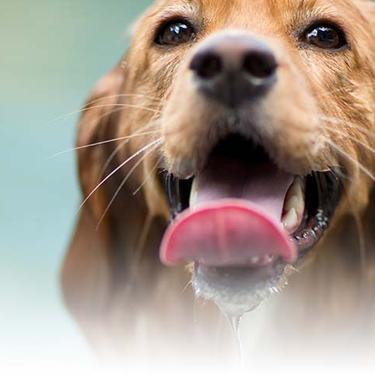

Yeast infections in dogs are a common problem, and can happen in and on several parts of the body. Even though yeast can grow anywhere on the skin, the areas that are most commonly affected include the ears, paws and skin folds.
Signs of a Yeast Infection
Dogs with ear yeast infections will have red, itchy ears that stink. They'll also likely have copious amounts of dark brown earwax. Dog ear yeast infections are very itchy, and affected dogs may constantly scratch their ears and shake their heads. They may also rub their ears along furniture or along the carpet — leaving their signature scent everywhere they rub — or groan when you scratch their ears.
If your dog has a skin yeast infection, their skin will be itchy and red. They may also experience hair loss and smell bad. If your dog is constantly chewing on their paws and the underside of the paw is red, swollen and smells bad, it could be a yeast infection. If a yeast infection goes on long enough, it can make the skin thicken and turn rough and black.
Causes of Yeast Infections in Dogs
Small numbers of Malassezia (the main genus of yeast that affects dogs) regularly live on healthy dogs. Normally, the immune system keeps yeast numbers in check. A yeast infection occurs when something compromises the health or balance of the skin or ears, causing yeast to overgrow. Conditions that can predispose dogs to yeast overgrowth include inhalant allergies, food allergies, hormonal conditions such as thyroid disease, diabetes, hyperadrenocorticism (Cushing Disease in dogs), and anything that negatively impacts the immune system.
In addition, dogs can develop a version of swimmer's ear. Yeast loves moisture. If your dog swims or plays in water a lot, or if you don't dry out their ears after bathing them, then the wet environment in the ear canal can predispose them to a yeasty ear infection.
What to Do If You Suspect Your Dog Has a Yeast Infection
If you think your dog is suffering from a yeast infection, then it's time to schedule an appointment with your veterinarian. If your dog does have a yeast infection, then that means two things:
- The overgrowth on your dog's skin or in your dog's ears needs to be addressed.
- The underlying condition that compromised the health of the skin or ears needs to be addressed.
If you don't correct or address the underlying condition, then even if you treat the yeast infection with anti-yeast medication, the problem will return. Treatment of the underlying cause depends on what it is and should be handled in partnership with a veterinarian. Allergies can be managed with special food, reducing exposure to allergies or allergy medication. Horm
How a Yeast Infection Gets Diagnosed
Veterinarians diagnose yeast infections in dogs through a combination of physical exam findings and simple lab tests. Your veterinarian will take a sample from the surface of your dog's skin or swab the ear, stain it and look at it under the microscope. Yeasts are easily identifiable under the microscope.
If your veterinarian suspects an underlying condition that's contributing to your dog's yeast woes, then they'll likely recommend additional testing to determine the root cause.

Made for dogs, led by science
We believe that science is the best path to giving your pet the best care possible.
Made for dogs, led by science
We believe that science is the best path to giving your pet the best care possible.
Treating a Yeast Infection
If your dog has a yeast infection in their ears, then your veterinarian will likely prescribe a combination of ear cleaning and topical medication that's applied to the ears. Cleaning ears is an important part of treatment, as it removes debris that can clog up the ear canal. If you've never cleaned your dog's ears, ask your veterinarian to show you how it's done. Your veterinarian may also prescribe a medicated lotion or cream to apply in your dog's ears once or twice daily after cleaning. Give this medicine as recommended by your veterinarian, don't skip doses and don't stop early — even if your dog is doing better. Yeast infections like to hide deep in ear canals and if you stop too soon, you risk creating drug resistance and your dog getting another infection.
Skin yeast infections can be treated in multiple ways. Your veterinarian might prescribe an oral anti-yeast medicine. However, topical treatments, such as prescription strength anti-yeast cream, lotion, shampoo and wipes, are also effective. If your dog has a yeast infection on their paws, medicated wipes or lotion can be effective.
If your dog has a widespread skin yeast infection, your veterinarian may prescribe shampoo with ketoconazole. The shampoo needs to be in contact with the skin for five to ten minutes before being rinsed off. If used properly and if the underlying cause is addressed, medicated shampoos are very effective in eradicating yeast overgrowth (and help your dog smell good too!). Be sure to follow your veterinarian's instructions regarding any prescribed treatments.
Preventing Yeast Infections in Dogs
Yeast infections are a sign that something else is going on. The most effective way to prevent your dog from getting a yeast infection is to address any underlying causes. It can be as simple as drying your dog's ears after they go for a swim. Be sure to take your dog in for yearly examinations and annual bloodwork. That way, your veterinarian can make sure to promptly treat any underlying issues, including hormonal problems or allergies. If your dog has a food allergy, talk with your veterinarian about trying a prescription food that either has limited ingredients or is hypoallergenic.



















